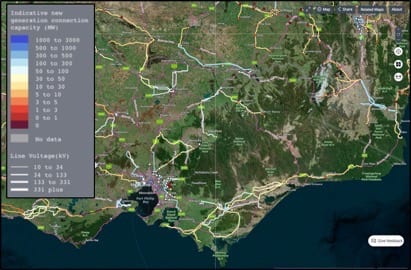Have you ever thought about developing a local solar farm? Have you got a few sites in mind but not sure how much the grid can handle?
In years gone by the answer to these questions for most people was most definitely no. But in 2017 as the distributed energy transition steamrolls on and innovative start-ups, communities and local governments step up to play with the industry ‘big guys’, increasingly the answer is ‘hell yes!’
Technology improvements are lowering traditional barriers to market entry, providing more efficient processes for investors to seriously consider project viability in terms of it best serving network needs. This leads to better investments and projects that improve the network.
For example, information on network grid connection capacity is generally only obtained via a formal connection enquiry process and requires you to have a location already identified. But without knowing the capability of the network, the information coming back might result in a proponent completely rethinking at what scale or where they site their generator.
New technology has addressed this issue with the release of the “New Generator Connection Opportunities” layers – the latest open data offering from UTS and a coalition of electricity network businesses – which form part of the recently released broader Network Opportunity Maps on Data61’s AREMI platform.
New Generator Connection Opportunities reveal Victorian data right down to the zone substation level

These new layers provide first pass ‘indicative connection capacity’ data up front, making things faster and easier for both the proponent and the network.
For new players in the market, this could spark a whole new community or business opportunity. For network businesses, proponents having access to this data upfront means that connection applications are more likely to be successful and result in fewer design iterations.
Crucially, the layers can be updated at any time by the network as circumstances change or new projects are committed. This is particularly important in Victoria, where the Victorian Renewable Energy Target is driving major new investment in embedded generation, and rapid detailed data is needed to streamline the connections process.
With the data on the AREMI platform alongside grid constraint deferral opportunities and renewable energy resource data, users can triangulate the best opportunities to match local supply and demand to deliver low-carbon, low-cost electricity. Check out how in a 7-minute video case study.
Tom Langstaff, Lead Engineer in Strategic Network Planning for Victorian Network Service Provider AusNet Services, talks to their drivers for pursuing these new maps:
“We’re supportive of smart technology that encourages investment in projects aligned to network capacity. It’s important to us that we empower communities and their energy future. By providing an initial assessment of our networks’ capacity to support embedded generation, we hope to make the challenging first step of locating embedded generation easier for our customers.
We aim to reduce the time spent in the initial stages of project development and ensure the most cost-efficient network connection for projects. Empowering our customers with timely, high quality network information allows AusNet Services to support customers in developing more timely and economically viable projects that support the needs of our customers and the network.”
We have not yet seen a depth of activity in the community-scale locally owned renewable energy space (1-20 MW scale), but the recent announcement of The Goulburn Group’s planned community-funded 1.2 MW ground-mounted solar farm (see here and here) is an example of the type of project where regional communities are taking matters into their own hands. This new dataset will make future projects in this space faster and easier.
To connect to the grid you still need to go through the generator connections enquiry process, but this is a great first step in using open data to empower new players to participate in a more distributed, democratised energy future.
We hope that this is a stepping stone to regional areas attracting locally appropriate renewable energy development close to load centres.
With industry and community collaborating, we can turn regional ‘jobs and growth’ from a media soundbite into tangible projects that simultaneously tackle our climate and energy woes.
The New Generation Connection Capacity Map layers were produced by The Institute for Sustainable Futures at UTS in collaboration with CSIRO’s Data61, with the financial support of ARENA, AusNet Services and Powerlink, and in-kind support from TransGrid and Energy Networks Australia.
Currently the maps have data from transmission companies Powerlink (Qld), TransGrid (NSW), AEMO/AusNet Services (Victoria) and ElectraNet (SA), and rural distributors AusNet Services and Powercor (Victoria) and Essential Energy (NSW). Other distributors are watching the space closely, so if the area you’re interested in doesn’t have data, drop your local network business a line and let them know there is demand!
Check out:










